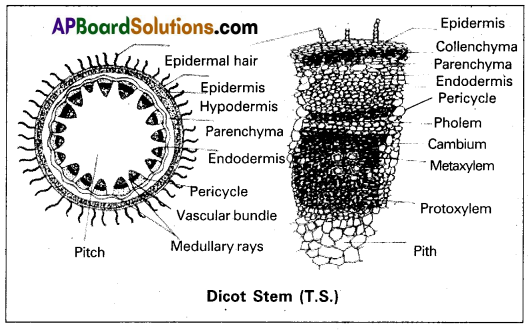Successful navigation through TS Inter 1st Year Botany Model Papers and TS Inter 1st Year Botany Question Paper March 2015 builds students’ confidence in their exam-taking abilities.
TS Inter 1st Year Botany Question Paper March 2015
Time: 3 Hours
Maximum Marks: 60
General Instructions:
Note : Read the following instructions carefully.
- Answer all questions of Section ‘A’. Answer any six questions out of eight questions in Section ‘B’ and answer any two questions out of three in Section – ‘C’.
- In Section ‘A’, questions from Sr. Nos. 1 to 10 are of “Very Short Answer Type”. Each question carries two marks. Every answer may be limited to five lines. Answer all the questions at one place in the same order.
- In Section ‘B’, questions from Sr. Nos. 11 to 18 are of “Short Answer Type”. Each question carries four marks. Every answer may be limited to 20 lines.
- In Section-C, questions from Sr. Nos. 19 to 21 are of “Long Answer Type”. Each question carries eight marks. Every answer may be limited to 60 lines.
- Draw labelled diagrams wherever necessary for questions in Section ‘B’ and C.
Section – A (10 × 2 = 20)
Note : Answer all questions. Each answer may be limited to 5 lines.
Question 1.
Define population and Community.
Answer:
“A group of similar individuals belonging to the same species found in an area’1 is called population. An assemblage of all the population occuring in an area” is called community.
Question 2.
What is Geocarpy ? Name the plant which exhibits this pheno-menon.
Answer:
Development of fruits inside the soil is called Geocarpy. It is seen in Arachis hypogea (Ground nut).
Question 3.
What is Paleobotany ? What is its use ?
Answer:
Study of fossil plants is called Palaeobotany. It helps in under – standing the course of evolution in plants.
![]()
Question 4.
Give the main criteria used for classification by Whittaker.
Answer:
The main criteria for classification proposed by Whittaker include cell structure, thallus organisation, mode of nutrition, reproduction and phylogenetic relationships.
Question 5.
What is Flora ?
Answer:
The actual account of Habitat, distribution and systematic listing of plants of a given area is called flora.
Question 6.
Mention a single membrane bound organelle which is rich in hydrolytic enzymes.
Answer:
Lysosome.
Question 7.
Name the stage of meiosis in which actual reduction in chromosome number occurs.
Answer:
Starts in anaphase I and is complete by telophase I.
Question 8.
Starch, Cellulose, Glycogen, Chitin are polysaccharides found among the following. Choose the one appropriate and write against each.
a) Cotton fibre
b) Exoskeleton of Cockroach,
c) Liver
d) Peeled Potato.
Answer:
a) Cotton fibre : Cellulose
b) Exoskeleton of cockroach : Chitin
c) Liver : Glycogen
d) Peeled potato : Starch
![]()
Question 9.
Differentiate between Racemose and Cymose Inflorescence.
Answer:
| Racemose Inflorescence | Cymose inflorescence |
| 1) Peduncle grows indefinitely. | 1) Peduncle grows definitely. |
| 2) Flowers are arranged in acropetal manner on the peduncle. | 2) Flowers are arranged in Basipetal manner on the peduncle. |
| 3) Flowers open in a centripetal manner. | 3) Flowers open in a centrifugal manner. |
Question 10.
Define Placentation. What type of placentation is found in Dianthus ?
Answer:
The arrangement of ovules with in the ovary is known as placentation. In dianthus. Free central placentation is found.
Section – B (6 × 4 = 24)
Note : Answer any six questions. Each answer may be limited to 20 lines.
Question 11.
Describe the essential organs of Solanaceae.
Answer:
Androecium and Gynoecium are the essential organs.
Androecium : Stamens 5, epipetalous, alternating with petals anthers are dithecous, basifixed, Introrse and dehisce longitudinally ‘Datura) or porous (Solanum).
Gynoecium : Bicarpellary, syncarpous, bilocular, superior ovary with many ovules on swollen axile placentation. Style is terminal and stigma is capitate. Carpels are arranged obliquly at 45°. (Posterior carpel to the right and anterior carpel to the left).
Question 12.
What is Heterospory ? Briefly comment on its significance. Give two examples.
Answer:
Production of different types of spores (2 types) is called Heterospory.
Significance : The smaller microspore forms male gametophyte which intern produce male gametes. The larger megaspore forms female gametophyte which produce female gamete, the Egg. The Male gamete fuses with the egg forms Diploid zygote.
This retention and germination of the megaspore with in the megasporangium ensures proper development of zygote. The zygote develops into the future sporophyte. The evolution of the seed habit is released to the retention of the Megaspore. Heterospory is considerd as an important step in evolution as it is a precursor to the seed habit.
Ex : Selagenella, Salnnia.
Question 13.
Give a brief account of Dinoflagellates.
Answer:
- Dinoflagellates are mostly marine and photosynthetic. They appear yellow green, brown, blue or red depending on the pigments in their cells.
- The cell wall has stiff cellulose plates on the outer surface.
- They have two flagella and produce spinning movements. So these prOtists are called “whirling whips”.
- The nucleus has condensed chromosomes which are without histones. This is called mesokaryon.
- Some dinoflagellates like Noctiluca show bioluminescene.
- Red dinoflagellates like Gonyaulax undergo rapid multiplication and make the sea appear red (Red tides in Medeterranian sea).
- Toxins produced by them may kill fishes.
Question 14.
Distinguish between asexual and sexual reproduction. Why is vegetative reproduction also considered as a type of asexual reproduction ?
Answer:
| Asexual Reproduction | Sexual Reproduction |
| 1. Single parent is involved. | 1. Two parents take part in reproduction. |
| 2. Offsprings are genetically identical to each other and to their parent. | 2. Variations occurs in offspring, |
| 3. No internal fertilization or external fertilization. | 3. Fertilisation takes place. |
| 4. No gamete formation. | 4. Gametes are formed. |
| 5. No mixing of hereditary material. | 5. Mixing of hereditary material. |
In multicellular or colonial forms of algae, moulds and mushrooms, the body may split/break or get separated into smaller fragments. Each fragment thus formed develops into a mature individual. This process is called fragmentation.
Some plants have specialized structures for reproduction called gemmae (in liverworts).
In flowering plants, the units of vegetative propagation such as runners, stolons, suckers, offset, rhizomes, corm, stem tuber, bulb, bulbil, reproductive leaves are capable of giving rise to new offsprings. These structures are called vegetative propagules. In all these plants, no involvement of sex organs takes place, so vegetative reproduction is also a sexual reproduction.
![]()
Quetsion 15.
What are Hydrophytes ? Briefly discuss the different kinds of hydrophytes with examples.
Answer:
The plants which grow in water or in very wet places. According to the way in which they develop in water, they are further subdivided into the following five categories.
i) Free floating hydrophytes : They float freely on water surface and have no contact with soil.
Eg : Pistia, Eichhornia, Wolffia, Salvinia.
ii) Rooted hydrophytes with floating leaves : Their roots are fixed in mud, but leaves have long petioles which keep them floating on the water surface.
Eg : Nymphaea, Nelumbo and Victoria regia.
iii) Submerged suspended hydrophytes : These plants are in contact with only water, being completely submerged and not rooted in the mud.
Eg : Hydrilla, Ceratophyllum and Utricularia.
iv) Submerged rooted hydrophytes: These plants are completely submerged in water and attached to the substratum by their root system.
Eg : Vallisneria, Potamogeton etc.
v) Amphibious plants : These live partly in water and partly in air.
Eg : Sagittaria, Rannunculus, Llmnophila, Typha etc.
Question 16.
State the location and function of different types of meristems.
Answer:
Based on the position, meristems are classified into three types.
A) Apical Meristems: The meristems that are present at the tip of the root and at the tip of the stem or branches are called Apical Meristems. They help in the linear growth of the plant body.
B) Intercalary Meristems : The Meristems that are present in between mature tissues are known as Intercalary Meristems. They occur in grasses. They also contribute to the formation
of the primary plant body and involve in internodal growth.
C) Lateral Meristems : The meristems that occur in the mature regions of roots and shoots of many plants are called lateral meristems. They help in increase in thickness of the plant organs (Root, Stem). Ex : Vascular cambium, cork cambium.
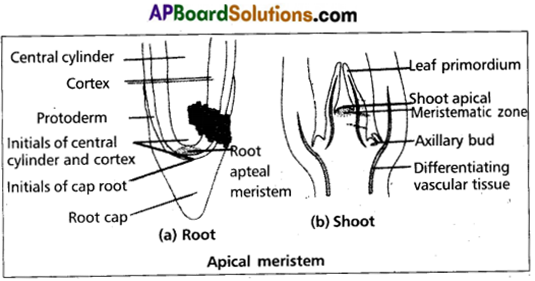
Question 17.
Describe the structure of Nucleus.
Answer:
It is a spherical ball like structure which controles and coordinates various life activities of a cell and is considered to be the most important cell organella or cell brain. It was discovered by Robert Brown. It shows four parts.
They are :
a) Nuclear membrane : The Nucleus is covered by 2 layered envelope which are seperated by perinuclear space. It is lipo-proteinous in nature, acts as a bridge between cytoplasm and Nucleoplasm. It is porous at some places called Nuclear pores.
b) Nucleoplasm : The homogenous, semi solid substance inside the Nuclear membrane is called Nucleoplasm or Karyoplasm. It is composed of Glyco Proteins, Ribonucleo Proteins Hydrolysing enzymes, DNA & RNA polymerases, chromatin material and nucleolus.
c) Chromatin Material: The deeply stained network like material is called chromatin material. It is associated with DNA & Histone proteins. It transforms into thick rod shaped structures called chromosomes during cell division.
d) Nucleus : It is a spherical body found in nucleoplasm. It was discovered by Fontana. It is the seat for the production of Ribosomes.
Functions :
- It controls and co-ordinates the function of all cell organelles so called cell brain.
- It involves in heridity.
- It plays an important role in reproduction in unicellular organisms.
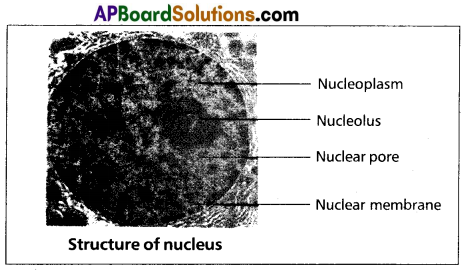
![]()
Question 18.
Nucleic acid exhibits secondary structure. Justify with example.
Answer:
Nucleic acids exhibits a wide variety of secondary structure. For example, one of the secondary structures exhibited by DNA is Watson- Crick model. According to this, DNA exists as a double helix. The two stands of polynucleotides are antiparallel i.e., run in the opposite direction. The back bone is formed by the sugar – phosphate, sugar chain. The nitrogen bases are projected more or less perpendicular to this backbone but face inside. A combines with T by two hydrogen bonds where G combines with C by three hydrogen bonds. One full turn of the helical strand would involve ten base pairs. The length of one coil is 34 A and the distance between base pairs is 3.4 A. It is also called B-DNA.
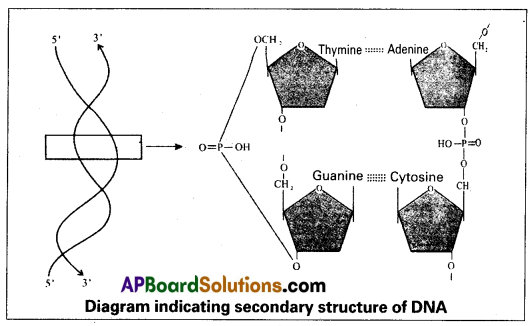
Section – C (2 × 8 = 16)
Note : Answer any two questions. Each answer may be limited to 60 lines.
Quetsion 19.
Define Root modification. Explain how root is modified to perform different functions (write any 6 modifications).
Answer:
A change in the normal structure of root to carryout new functions according to environment is called root modification.
Root modifications :
- Storage Roots : In Carrot, turnip (Tap roots). Sweat potato (Adventitious roots), Asparagus (Fibrous roots) become swollen due to storage of food called storage roots.
- Prop Roots : In Banyan tree, roots arise from the branches grow into the soil, become pillar like and give additional support called prop roots or Pillar roots.
- Stilt Roots : In Maize, sugarcane, roots arise from the lower nodes of the stem, give additional support called stilt roots.
- Respiratory Roots : In Mangroves like Rhizophora and Avicennia, Many roots come out of the ground and grow vertically upwards, help in respiration called Pneumato – phores.
- Epiphytic Roots: In epiphytes like Vanda, special adventitious roots arise, help in absorption of moisture from atmosphere called Velamen roots.
- Parasitic Roots : In partial parasites like viscum and Striga, some haustorial roots enter into xylem of the host plant to get water and minerals. In complete parasities like cuscuta and Rafflesia, the haustorial roots enter into xylem and phloem of the host plant and obtain water, minerals and food materials called parasitic roots.
- Nodular Roots : In the members of Fabaceae, the roots are inhabited by Rhizobium bacteria which helps in N? fixation called nodular roots.
- Photo synthetic Roots : In some plants like Taeniophyllum, the roots are chlorophyllous and perform photosynthesis so called photosynthetic roots.
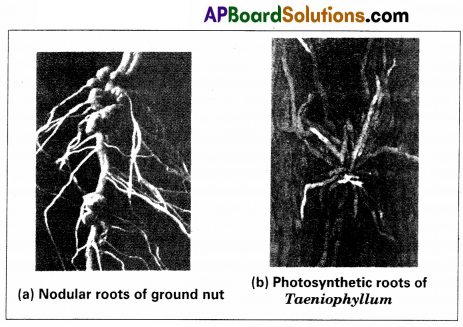
Question 20.
Describe the process of fertilization in Angiosperms with labelled diagrams.
Answer:
The fusion of male and female gametes is called fertilization. The process of fertilization in angiosperms is described under the following five steps.
A) Entry of the pollen tube into the ovule : The pollen tube enters into the ovule in 3 ways.
- Pologamy : Pollen tube enters into the ovule through microphyle. Ex. : Ottelia, Hibiscus.
- Chalazogamy : Pollen tube enters into the ovule through chalaza. Ex. : Casuarina.
- Mesogamy : Pollen tube enters into the ovule through integu-ments or funiculus. Ex. : Cucurbita.
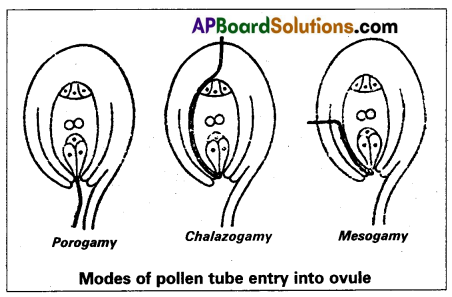
B) Entry of pollen tube into the embryosac : The pollen tube enters into the embryosac only through the microphylar region either by destroying one of the synergids or in between egg cell and synergid. The entry of pollen tube is directed by filiform apparatus.
C) Dicharge of male gametes or sperms : After entry of pollen tube into the embryosac, the male gametes are liberated by one of the following ways.
a) Tip of the pollen tube may burst out.
b) Degeneration of the tip of the pollen tube.
c) Formation of an apical pore at the tip of the pollen tube. The pollen tube finally releases the intact male gametes and vegetative nucleus.
D) Gametic Fusion: One of the two nuclei, one nucleuses sperm nucleus [first sperm] fuses with egg cell and forms a dipliod zygote (2n). This fusion is called syngamy or fertilization. It was first discovered by Strasburger (1884).
E) Triple fusion and Double fertilization : The second nucleus fuses with the secondary nucleus of the embryosac and forms Primary endosperm nucleus [PEN]. This fusion is called as Triple fusion. It was first observed by Nawaschin in Lilium and Fertillaria. In angiosperms the two male gametes release into the embryo sac take part in two fertilizations.
The first sperm nucleus combines with egg cell to form zygote and the second sperm nucleus combines with secondary nucleus to form primary endosperm nucleus. With the occurrence of two fertilizations, this phenomenon is, i.e., Double fertilization includes syngamy as well as triple fusion. It results in the formation of fertile endospermic seeds.
![]()
Question 21.
Describe the T.S. of Dicot stem with a neat labelled diagram.
Answer:
The structure of young dicot stem can be clearly understood by observing the transverse section of stem of Helianthus annus (sunflower). It shows three major zones, namely epidermis, cortex and stele.
1. Epidermis : It is the outer most layer of rectangular or tabular cells arranged compactly without any intercellular spaces. On outer surface of epidermis, a waxy layer called Cuticle is found. The cuticle is chemically composed of a substance cutin. The cell walls of epidermis also show the presence of cutin. Stomata are present in the epidermis. Multicellular trichomes develop on the epidermis. The cuticle and the trichomes check the evaporation of water and protect the stem from high temperature.
The epidermal layer gives protection to the inner tissues and also prevents the evaporation of water from the plant body. Through stomata, the epidermis allows the exchange of gases and promotes transpiration. Trichomes prevent entry of pathogens.
2. Cortex : The part extending between the epidermis and the stele is known as cortex. The cortex is smaller than the stele. It shows three sub-zones, namely
i) Hypodermis
ii) General Cortex and
iii) Endodermis.
i) Hypodermis: This is the outermost part of cortex and composed of 3-6 rows of collenchymatous cells. It is found beneath the epidermis and helps in providing tensile strength (elasticity) to the stem. The cells are arranged compactly without intercellular spaces and show excessively thickened corners. The cells are filled with active vacuolated cytoplasm possessing chloroplasts. Thus, the hypodermis also helps in the assimilation of food materials. It also gives mechanical strength.
ii) General Cortex : It is found beneath the hypodermal layer and is made up of 5 – 10 rows of thin walled, living parenchyma cells with or without intercellular spaces. The outer layers of cells contain chloroplasts and in the inner layers, leucoplasts are found. The general cortex is primarily concerned with the assimilation and storage of food materials.
iii) Endodermis : The inner most layer of cortex is called endo- dermis. The cells are barrel shaped, compactly arranged without intercellular spaces. The endodermis cells contain vacuolated protoplasts and show starch grains. So it is also known as ‘Starch Sheath’.
3) Stele : The central conducting cylinder is called the ‘Stele’. It occupies a major part of the stem. It is composed of 4 parts.
i) Pericyde
ii) Vascular bundles
iii) Pith or Medulla and
iv) Medullary rays.
i) Pericyde : It is present in the form of a discontinuous ring and is made up of 3 – 5 rows of the thick walled, dead, lignified cells which gives mechanical strength to the stele. It appears as semilunar patches of sclerenchyma above the vascular bundles with intervening masses of parenchyma.
ii) Vascular bundles : About 15 – 20 vascular bundles are arranged in the form of a ring. This arrangement is called Eustele. Each vascular bundle is wedge or top shaped. In the vascular bundels, xylem and phloem are arranged on the same radius. A meristematic layer of cells called cambium is present in between the xylem and phloem. So they are called conjoint, collateral and open vascular bundles. Xylem is at the lower side and phloem at the upper side of the vascular bundle.
Xylem consists of vessels and xylem parenchyma. There may be few tracheids and xylem fibres. The metaxylem is towards the pericyde and protoxylem towards the pith. This is called endarch xylem. Phloem consists of sieve tubes companion cells and phloem parenchyma. Xylem and phloem are vascular tissues which conduct water, mineral salts and organic solutes respectively.
iii) Medulla (or) pith : It is the central part of the stele and filled with thin walled parenchymatous cells, showing intercellular spaces. It is well – developed, extensive and occupies a large part of the stele. The chief function of the medulla is to store food materials.
iv) Medullary rays : They are found in between the vascular bundles. They show many horizontal rows of thin walled radially elongated living cells which help in lateral conduction of food materials.
